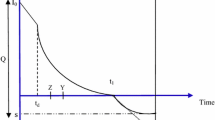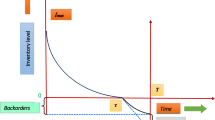Abstract
In any business transaction the constant unit price assumption is not true. The tendency in inflationary environment is to buy more in order to reduce the total system cost, which may be true in certain situations but it is not true when consumption rate of items is dependent on initial stock level since buying more quantity under inflationary environment leads to more consumption resulting in higher total system cost. The model developed in this paper helps to determine optimum ordering quantity for stock dependent consumption rate items under inflationary environment with infinite replenishment rate without permitting shortages. The effect of the inflation rate, deterioration rate, Initial-stock-dependent consumption rate and delay in payment are discussed. This study develops an inventory model for constant demand rate and time dependent deterioration rate with delay in payment is discussed. In this study mathematical model are also derived under two different cases. Case-I: The credit period is less then cycle time T; and Case-II: Credit period is greater than cycle time T. This study will proposes an inventory model under a situation in which the supplier provides the purchaser a permissible delay of payments if the purchaser orders a large quantity. Numerical example is given to support the purposed model. Mathematica 7.0 is used for numerical solutions.


Similar content being viewed by others
References
Abad, P.L.: Optimal lot size for a perishable good under conditions of finite production and partial backordering and lost sale. Comput. Ind. Eng. 38, 457–465 (2000)
Baker, R.C., Urban, L.T.: A deterministic inventory system with an inventory-level-dependent demand rate. J. Op. Res. Soc. 39, 823–831 (1988)
Chang, H.J., Dye, C.Y.: An EOQ model for deteriorating items with time-varying demand and partial backlogging. J. Op. Res. Soc. 50, 1176–1182 (1999)
Chung, K.J., Hung, C.H., Dye, C.Y.: An inventory model for deteriorating items with linear trend demand under the condition of permissible delay in payments. Prod. Plan. Control 12, 274–282 (2001)
Datta, T.K., Paul, K., Pal, A.K.: Demand promotion by up gradation under stock-dependent demand situation–a model. Int. J. Prod. Econ. 55, 31–38 (1998)
Ghiami, Y., Williams, T.: A two-echelon production-inventory model for deteriorating items with multiple buyers. Int. J. Prod. Econ. 159, 233–240 (2015)
Ghosh, S.K., Chaudhuri, K.S.: An order-level inventory model for a deteriorating item with Weibull distribution deterioration, time-quadratic demand and shortages. Int. J. Adv. Model. Optim. 6(1), 21–35 (2004)
Giri, B.C., Pal, S., Goswami, A., Chaudhari, K.S.: An inventory model for deteriorating items with stock-dependent demand rate. Euro. J. Op. Res. 95, 604–610 (1996)
Gupta, R., Vrat, P.: Inventory model with multi-items under constraints systems for stock dependent consumption rate. Op. res. 24, 41–42 (1986)
Hollier, R.H., Mak, K.L.: Inventory replenishment policies for deteriorating items in a declining market. Int. J. Prod. Res. 21, 813–826 (1983)
Hou, K.L.: An inventory model for deteriorating items with stock-dependent Consumption rate and shortages under inflation and time discounting. Eur. J. Oper. Res. 168(2), 463–474 (2006)
Khanra, S., Ghosh, S.K., Chaudhuri, K.S.: An EOQ model for a deteriorating item with time dependent quadratic demand under permissible delay in payment. Appl. Math. Comput. 218(1), 1–9 (2011)
Lee, S., Kim, D.: An optimal policy for a single-vendor single-buyer integrated production-distribution model with both deteriorating and defective items. Int. J. Prod. Econ. 147, 161–170 (2014)
Mandal, B.N., Phaujdar, S.: An inventory model for deteriorating items and stock dependent consumption rate. J. Op. Res. Soc. 40, 483–488 (1989)
Padmanabhan, G., Vrat, P.: EOQ models for perishable items under stock dependent selling rate. Euro. J. Op. Res. Soc. 86, 281–292 (1995)
Pal, S., Goswami, A., Chaudhari, K.S.: A deterministic inventory model for deteriorating items with stock-dependent demand rate. Int. J. Prod. Econ. 32, 291–299 (1993)
Papachristos, S., Skouri, S.: An optimal replenishment policy for deteriorating items with time-varying demand and partial–exponential type–backlogging. Oper. Res. Lett. 24(4), 175–184 (2000)
Papachristos, S., Skouri, K.: An inventory model with deteriorating items, quantity discount, pricing and time-dependent partial backlogging. Int. J. Prod. Econ. 83, 247–256 (2003)
Park, K.S.: Inventory models with partial backorders. Int. J. Syst. Sci. 13, 1313–1317 (1982)
Rau, H.L., Wu, M.Y., Wee, H.M.: Deteriorating item inventory model with shortage due to supplier in an integrated supply chain. Int. J. Syst. Sci. 35(5), 293–303 (2004)
Ray, J., Chaudhuri, K.S.: An EOQ model with stock-dependent demand shortage, inflation and time discounting. Int. J. Prod. Econ. 53, 171–180 (1997)
Ray, J., Goswami, A., Chaudhuri, K.S.: On an inventory model with two levels of storage and stock-dependent demand rate. Int. J. Syst. Sci. 29, 249–254 (1998)
RoyChowdhury, R., Ghosh, S.K., Chaudhuri, K.S.: The effect of imperfect production in an economic production lot size model. Int. J. Manag. Sci. Eng. Manag. 10(4), 288–296 (2014). doi:10.1080/17509653.2013.867097
Sarkar, T., Ghosh, S.K., Chaudhuri, K.S.: An economic production quantity model for items with time proportional deterioration under permissible delay in payments. Int. J. Math. Op. Res. 5(3), 301–316.5 (2013)
Sicilia, J., Rosa, M.G.: De-la, Acosta, J.F., Pablo, L.D.: An inventory model for deteriorating items with shortages and time-varying demand. Int. J. Prod. Econ. 155, 155–162 (2014)
Taleizadeh, A.A., Daryan, M.N., Barron, L.E.C.: Joint optimization of price, replenishment frequency, replenishment cycle and production rate in vendor managed inventory system with deteriorating items. Int. J. Prod. Econ. 159, 285–299 (2015)
Taleizadeh, A.A., Nematollahi, M.: An inventory control problem for deteriorating items with back-ordering and financial considerations. Appl. Math. Model. 38, 93–109 (2014)
Taleizadeh, A.A., Pentico, D.W., Jabalameli, M.S., Aryanezhad, M.: An EOQ problem under partial delayed payment and partial backordering. Omega 4(2), 354–368 (2013a)
Taleizadeh, A.A., Pentico, D.W., Jabalameli, M.S., Aryanezhad, M.: An economic order quantity model with multiple partial prepayments and partial backordering. Math. Comput. Model. 57(3–4), 311–323 (2013b)
Taleizadeh, A.A., Wee, H.M., Jolai, F.: Revisiting fuzzy rough economic order quantity model for deteriorating items considering quantity discount and prepayment. Math. Comput. Model. 57(5–6), 1466–1479 (2013c)
Taleizadeh, A.A.: An economic order quantity model with consecutive payments for deteriorating items. Appl. Math. Model. 38, 5357–5366 (2014)
Taleizadeh, A.A.: An economic order quantity model with partial backordering and advance payments for an evaporating item. Int. J. Prod. Econ. 155, 185–193 (2014)
Tal, R., Taleizadeh, A.A., Esmaeili, M.: Developing EOQ model with non-instantaneous deteriorating items in vendor-managed inventory (VMI) system. Int. J. Syst. Sci. 46(7), 1257–1268 (2015)
Tyan Lo, S., Wee, H.M., Huang, W.C.: An integrated production-inventory model with imperfect production processes and Weibull distribution deterioration under inflation. Int. J. Prod. Econ. 106(1), 248–260 (2007)
Wang, W.C., Teng, J.T., Lou, K.R.: Seller’s optimal credit period and cycle time in a supply chain for deteriorating items with maximum lifetime. Euro. J. Op. Res. 232, 315–321 (2014)
Wee, H.M.: A deterministic lot-size inventory model for deteriorating items with shortages and a declining market. Comput. Op. Res. 22, 345–356 (1995)
Wee, H.M., Lee, M.C., Yu, J.C.P., Wang, C.E.: Optimal replenishment policy for a deteriorating green product: life cycle costing analysis. Int. J. Prod. Econ. 133, 603–611 (2011)
Wu, J., Ouyang, L.Y., Barron, L.E.C., Goyal, S.K.: Optimal credit period and lot size for deteriorating items with expiration dates under two-level trade credit financing. Euro. J. Op. Res. 237, 898–908 (2014)
Yang, H.L.: Two-warehouse inventory models for deteriorating items with shortages under inflation. Eur. J. Oper. Res. 157(2), 344–356 (2004)
Author information
Authors and Affiliations
Corresponding author
Rights and permissions
About this article
Cite this article
Tripathi, R.P., Chaudhary, S.K. Inflationary Induced EOQ Model for Weibull Distribution Deterioration and Trade Credits. Int. J. Appl. Comput. Math 3, 3341–3353 (2017). https://doi.org/10.1007/s40819-016-0298-9
Published:
Issue Date:
DOI: https://doi.org/10.1007/s40819-016-0298-9




